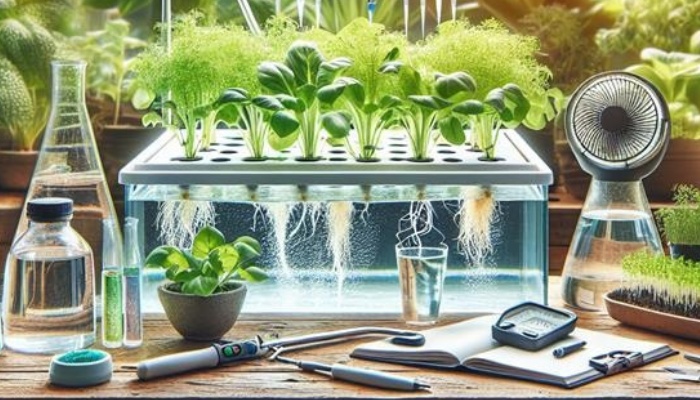Managing your watery garden requires vigilance and strategy.
By selecting suitable plants, maintaining optimal water quality, ensuring proper aeration, undertaking regular system cleaning, and monitoring nutrient levels, you’ll be equipped to prevent the dreaded root rot.
How exactly do you apply these strategies effectively? Let’s explore simple yet impactful measures to keep your hydroponic plants thriving and root rot at bay.
1. Choose Suitable Plants
Selecting plants that are naturally more resistant to root rot can significantly enhance the success of your hydroponic garden. Plant hardiness and specific growth habits play a large role in determining a plant’s resilience against root rot.
When you opt for varieties known for their robust root systems and adaptability to hydroponic environments, you’re setting the stage for a thriving garden without the constant battle against rot.
| Plant Type | Reason for Suitability |
|---|---|
| Lettuce | Fast-growing, less time for root rot to develop |
| Basil | Strong roots, resistant to moisture-related diseases |
| Spinach | Quick turnover, resilient to soggy conditions |
| Watercress | Naturally water-loving, thrives in hydroponic systems |
| Tomatoes | Deep root systems, adaptable to various conditions |
Understanding the growth habits of these plants can guide your selection process. For instance, plants with fast growth rates, like lettuce and spinach, spend less time in vulnerable stages where root rot could take hold.
Similarly, species that naturally thrive in moist or aquatic environments, such as watercress, exhibit an innate resistance to the conditions that typically favor root rot.
2. Maintain Optimal Water Quality
Ensuring optimal water quality is key in preventing root rot in hydroponic plants because it directly impacts plant health by influencing nutrient uptake and oxygen availability.
It is important to maintain water temperature within the ideal range, typically between 65-75°F (18-24°C).
Temperatures outside this range can lead to decreased oxygen solubility in water and promote the growth of harmful pathogens that contribute to root rot.
A water chiller or heater can be instrumental in stabilizing temperatures, ensuring your plants’ root systems are neither too cold to absorb nutrients nor too warm, which leads to a breeding ground for diseases.
Equally important is managing the pH balance of your hydroponic system. The sweet spot for most plants lies between 5.5 and 6.5. At this range, plants can best absorb the nutrients available in the water.
Using pH testers and adjusters regularly will help you keep the pH levels in check. This careful monitoring prevents nutrient lockout—a condition where plants can’t absorb nutrients—thereby reducing the risk of root rot significantly.
3. Ensure Proper Aeration
To prevent root rot in hydroponic systems, provide adequate aeration to the water. This ensures the roots receive sufficient oxygen for optimal growth.
Utilizing air pumps is one of the most effective methods to achieve this. By constantly introducing air into the water, you enhance the oxygenation process, which is vital for the health of your hydroponic plants.
Oxygenation techniques, such as the use of air stones or diffusers, further improve the efficiency of air pumps. These tools disperse air more evenly throughout the water, ensuring that oxygen reaches all parts of the root system.
It’s essential to select an air pump that’s appropriately sized for your hydroponic setup. An undersized pump won’t provide enough oxygen, leading to poor plant health and an increased risk of root rot.
Conversely, an oversized pump might disturb the plant roots or cause excessive water movement.
4. Regular System Cleaning
Regularly cleaning your hydroponic system plays a pivotal role in preventing root rot by eliminating pathogens and maintaining optimal growing conditions.
Establishing a consistent cleaning schedule ensures that harmful microorganisms don’t get the chance to establish colonies that could attack your plants’ roots.
It’s not just about removing visible dirt or debris; it’s about ensuring the entire system is free from potential threats that could compromise plant health.
Disinfection methods are key elements of your cleaning routine.
Utilizing hydrogen peroxide or isopropyl alcohol in the correct concentrations can effectively kill pathogens without damaging your plants or altering the nutrient balance of your solution.
It’s important to follow manufacturer recommendations when applying these disinfectants because misuse could lead to plant stress or system damage.
The process involves draining your system, applying the disinfectant, and thoroughly rinsing all components before refilling with fresh nutrient solution.
Pay special attention to areas that are prone to biofilm build-up, such as pumps, pipes, and reservoirs.
Regular inspection and cleaning of these areas can prevent the accumulation of organic matter, which is a breeding ground for pathogens that cause root rot.
5. Monitor Nutrient Levels
The balance of nutrients not only supports vigorous growth but also helps in preventing root rot, a common issue in hydroponics.
Here are three critical steps to ensure nutrient levels are kept in check:
- Regularly Test Nutrient Solutions: It’s essential to check the nutrient concentration in your hydroponic system periodically. Over-concentration can lead to nutrient burn, while under-concentration can starve your plants, both conditions making them susceptible to root rot.
- Implement pH Adjustments: The pH level of your nutrient solution impacts how well your plants can uptake nutrients. Most hydroponic plants thrive in a slightly acidic environment between 5.5 and 6.5. Regular pH adjustments ensure that nutrients remain bioavailable to your plants, reducing the risk of root diseases.
- Maintain Optimal Temperature: Temperature control is vital for nutrient absorption. Too cold and the plant’s metabolic rate slows, but too hot and you risk root oxygenation problems. Keeping your nutrient solution within the ideal temperature range (65-75°F or 18-24°C) promotes healthy root development and prevents rot.

